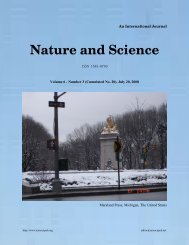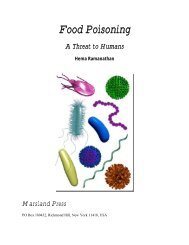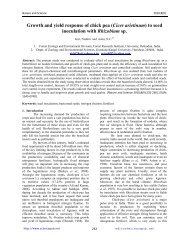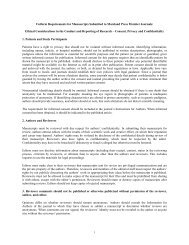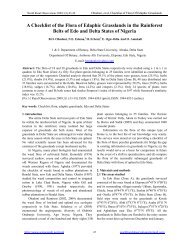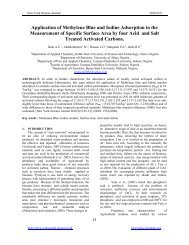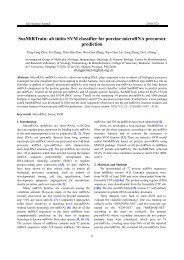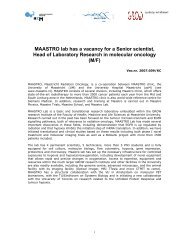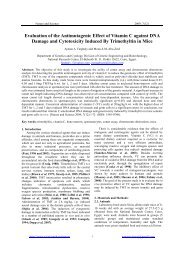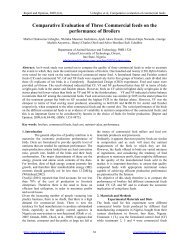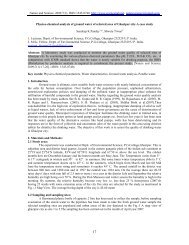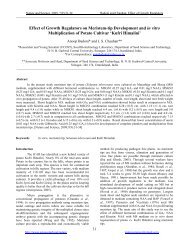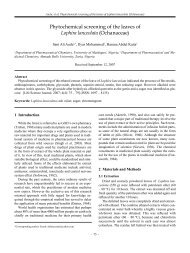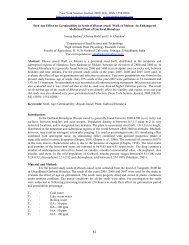Ecological, Social and Commercial Role of Lichens in India with ...
Ecological, Social and Commercial Role of Lichens in India with ...
Ecological, Social and Commercial Role of Lichens in India with ...
Create successful ePaper yourself
Turn your PDF publications into a flip-book with our unique Google optimized e-Paper software.
Acdemia Arena 2010, Supplement 0201<br />
http://www.sciencepub.net<br />
The phytosociological analysis <strong>of</strong> the fallen lichen vegetation was done by sampl<strong>in</strong>g <strong>of</strong> 40, 2M²<br />
ground quadrats on each site. All the <strong>in</strong>dividuals <strong>of</strong> fallen lichen genera were recorded carefully <strong>in</strong><br />
each sampled quadrat. The collected lichen samples were identified <strong>in</strong> the Lichen Laboratory, IBRI<br />
Lucknow. The data on fallen lichen vegetation were quantitatively analyzed for abundance, density,<br />
<strong>and</strong> frequency <strong>and</strong> A/F ratio by the follow<strong>in</strong>g formulas given by Curtis <strong>and</strong> Mc Intosh (1950).<br />
Total number <strong>of</strong> <strong>in</strong>dividuals<br />
Abundance =<br />
Number <strong>of</strong> quadrat occurrence<br />
Total number <strong>of</strong> <strong>in</strong>dividuals<br />
Density =<br />
Total number <strong>of</strong> quadrats studied<br />
Number <strong>of</strong> quadrats occurrence X 100<br />
Frequency (%) =<br />
Total number <strong>of</strong> quadrats studied<br />
Distribution <strong>of</strong> population: The ratio <strong>of</strong> abundance to frequency is a relative measure to present<br />
the distribution <strong>of</strong> fallen lichen vegetation <strong>in</strong> a community. Curtis <strong>and</strong> Cottam (1956) suggested the<br />
follow<strong>in</strong>g for regular (less than 0.025), contagious (0.025-.05) <strong>and</strong> r<strong>and</strong>om (more than 0.05)<br />
distribution <strong>of</strong> the population.<br />
RESULTS<br />
Quantitative analysis <strong>of</strong> fallen lichen vegetation at different study sites are given <strong>in</strong> Table 1. A<br />
total <strong>of</strong> 10 fallen lichen genera were recorded from the study area. The density <strong>of</strong> fallen lichen<br />
genera was recorded to be maximum 13175 <strong>in</strong>dividuals <strong>of</strong> Everniasteru ha¹ at site 1 st <strong>and</strong> 3 rd <strong>and</strong><br />
the m<strong>in</strong>imum density 125 <strong>in</strong>dividuals <strong>of</strong> Everniastrum ha¹ was recorded at site 9 th . Among the<br />
lichen vegetation maximum density was recorded for 26900 <strong>in</strong>dividuals <strong>of</strong> lichen ha¹ was recorded<br />
for site 1 st , <strong>and</strong> the m<strong>in</strong>imum density also recorded 6350 <strong>in</strong>dividuals <strong>of</strong> lichen ha¹ at site 6th (Table<br />
90



